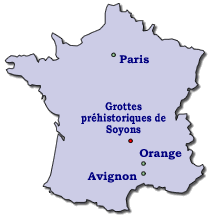 Höhlen in Frankreich Höhlen in Frankreich
 Grottes préhistoriques de Soyons Grottes préhistoriques de Soyons

 Commune de Soyons, Ardéche. 5 km von Valence. A7 (E15), Ausf. 14 oder 15 Valence, Richtung city centre, Beschilderung Guilherand/Granges auf der anderen Seite der Rhone. Commune de Soyons, Ardéche. 5 km von Valence. A7 (E15), Ausf. 14 oder 15 Valence, Richtung city centre, Beschilderung Guilherand/Granges auf der anderen Seite der Rhone.
Links abbiegen in Guilherand/Granges, 5 km bis Soyons.
 Kurzinfos Kurzinfos
 Adresse Adresse
Monsieur le Conservateur
Grottes Préhistoriques de Soyons
Place de la Déesse SOlO
07130 Soyons
Tel: +33-475-608886
Fax: +33-475-608112
 Geöffnet Geöffnet
Feb-Nov tägl. 10-12, 14-18
Jul-Aug tägl. 10-12:30, 13:30-19
 Führung Führung
60 Minuten
 Beleuchtung Beleuchtung
 Länge der Höhle Länge der Höhle
 Historie Historie
1870 excavation by Lepic and De Lubac.
1965 excavation in réseau Double-Borne by JL Brochier and E. Brochier.
1972 excavation in l'Abri Moula.
1987 museum opened to the public.
1989 excavation in réseau Ursus by G. Dal-Pra, G. Crouzet, and F. Reynaud.
1989 Trou du Renard opened to the public.
1999 Grotte de Néron opened to the public.
 Beschreibung Beschreibung
The Grottes préhistoriques de Soyons are numerous caves at the southern end of the village. They are located in the cliff of the Serre de Guercy.
Six of those grottes, Grotte de Néron, Les Enfants, Trou du Mouton (Sheeps hole), Trou Roland, la Madeleine, and Trou du Renard (fox hole), were excavated in 1870 by Lepic and De Lubac. Nearly 100 years later, in 1965, JL Brochier and E. Brochier excavated réseau Double-Borne. Now multiple excavations followed.
During paleolithic times, the grottes of the Serre de Guercy were home to neanderthals for numerous times. Inbetween the cave was used by animals, especially carnivores like bears, cave lions, and hyena. Later, in neolithic times, cro magnon people followed the Neanderthals. They used this place to slaughter a hunted Mammoth. And at the end of the neolithic, the place was even used as a burial place.
In the center of Soyons is the location of an interesting museum. In four rooms the history of this area from the stone age to the medeaval times are shown. The exhibits include remains of mammoths, cave lions, bears, and hyenas. A nearby excavation site is also part of the exhibitions. It shows continuous remains of the last 150.000 years.
 speleoressac.free.fr/ speleoressac.free.fr/
|

